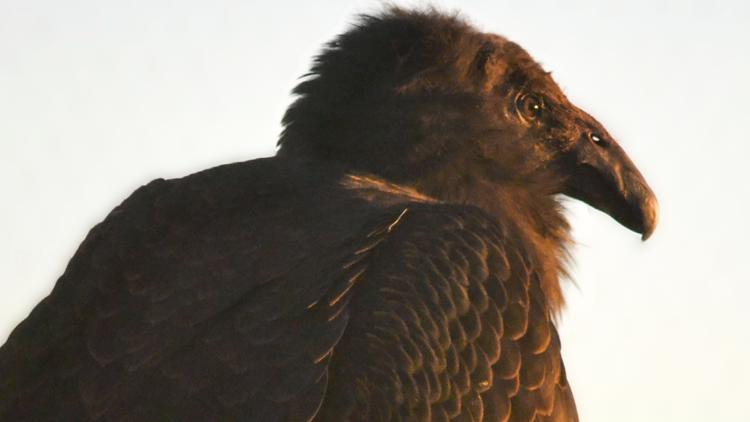MARBLE CANYON, Ariz. — By all accounts, Milagra the "miracle" California condor shouldn’t be alive today.
But now at nearly 17 months old, she is one of three of the giant endangered birds who got to stretch their wings in the wild as part of a release this weekend near the Grand Canyon.
Even after the door was opened Saturday, the birds didn’t immediately leave their pen. After 20 minutes, one condor left the pen, followed 20 minutes later by another condor.
Then, after sitting in the pen for an hour and 20 minutes, Milagra exited the enclosure and took flight. When a livestream of the wildlife release ended, a fourth condor remained in the pen, not ready to leave. For Milagra, there is no more appropriate name for a young bird that has managed to survive against all odds. Her mother died from the worst outbreak of avian flu in U.S. history soon after she laid her egg, and her father nearly succumbed to the same fate while struggling to incubate the egg alone.
Milagra, which means miracle in Spanish, was rescued from her nest and hatched in captivity thanks to the care of her foster condor parents.
The emergency operation was part of a program established about 40 years ago to help bring the birds back from the brink of extinction when their numbers had plummeted to fewer than two dozen.
The Peregrine Fund and the Bureau of Land Management streamed the release of Milagra and the others online Saturday from Vermilion Cliffs National Monument, about 50 miles (80 kilometers) from the Grand Canyon's North Rim.
Condors have been released there since 1996. But the annual practice was put on hold last year due to what is known as the “bird flu.” Highly Pathogenic Avian Influenza killed 21 condors in the Utah-Arizona flock.
“This year’s condor release will be especially impactful given the losses we experienced in 2023 from HPAI and lead poisoning,” said Tim Hauck, The Peregrine Fund’s California Condor program director.
Today, as many as 360 of the birds are estimated to be living in the wild, with some in the Baja of Mexico and most in California, where similar releases continue. More than 200 others live in captivity.
The largest land bird in North America with a wing-span of 9.5 feet (2.9 meters), condors have been protected in the U.S. as an endangered species since 1967. Many conservationists consider it a miracle any still exist at all.
Robert Bate, manager of the Vermilion Cliffs monument, said the release was being shared online in real time “so that the scope and reach of this incredible and successful collaborative recovery effort can continue to inspire people worldwide."
California condors mate for life with a lifespan up to 60 years and can travel up to 200 miles (322 kilometers) a day, which they have been known to do as they move back and forth between the Grand Canyon and Zion national parks.
The Peregrine Fund started breeding condors in cooperation with federal wildlife managers in 1993. The first was released into the wild in 1995, and it would be another eight years before the first chick was hatched out of captivity.
The fund's biologists typically don't name the birds they help raise in captivity, identifying them instead with numbers to avoid giving them human characteristics out of respect for the species.
They made an exception in the case of #1221, aka Milagra. They saw her journey as emblematic of the captive breeding program coming full circle.
Milagra's foster father, #27, was hatched in the wild in California in 1983. He was one of the first brought into the program as a nestling when fewer than two dozen were known to still exist worldwide.
Convinced it was the species' only hope for survival, the U.S. Fish and Wildlife Service made an unprecedented, risky decision back then to capture the remaining 22 known to exist to launch the breeding program. Over time, it has grown with assistance from the Oregon Zoo, Los Angeles Zoo and San Diego Zoo Safari Park.
“Once they realized California condors were great parents in captivity, they started allowing them to raise their own species,” said Leah Esquivel, propagation manager at the fund’s World Center for Birds of Prey in Boise, Idaho.
Like all California condors in the wild today, Milagra's biological parents were products of the program.
Milagra’s mother, #316, laid her softball-sized egg in a cave on the edge of an Arizona cliff in April 2023 — one of her last acts before she succumbed to avian flu. Sick himself, her biological father, #680, did his best to tend to the egg, but prospects for survival dwindled. So, when he made a rare departure from the nest, biologists who had been monitoring sick condors swooped in and snatched the lone egg.
“(He) was so focused on incubating the egg that he was not leaving to find food and water for himself, risking his own life,” Peregrine Fund spokesperson Jessica Schlarbaum said.
They stashed the fragile egg in a field incubator and raced 300 miles (480 kilometers) back to Phoenix, not unlike a human transplant team carrying a heart in an ice chest.
To the amazement of all, the egg hatched.
Milagra tested negative for the avian flu and spent about a week at the Liberty Wildlife Rehabilitation Center in Mesa, Arizona, before she was taken to fund’s breeding facility in Idaho, where the foster parents took her under their wings.
Esquivel, the propagation manager, said Milagra's foster mother, #59, has raised eight nestlings in her lifetime.
Esquivel described #59 as unique. While the bird never mates, she goes through all the other breeding motions each year and lays an egg.
“Her eggs are obviously infertile, but since she is a great mother, we use her and her mate to raise young,” Esquivel said. “We just swap the infertile egg out with a dummy egg, then place a hatching egg in the nest when we have one available for her.”
Milagra's foster dad has sired about 30 young and helped raise nestlings in captivity for years.
After spending about seven months with foster parents, the youngsters head off to “condor school” in California to learn the basics: eating communally, strengthening muscles for flight and learning to get along with fellow condors.
For the biologists, recovery partners, volunteers and others who have persevered over the last year, Hauck summed up Saturday's release of the birds from this year's graduating class as “a moment of triumph.”



